Enhanced TDS
Identification & Functionality
- INCI Name
- Manufactured By
- Cosmetic Ingredients Functions
- Technologies
- Product Families
Features & Benefits
- Benefit Claims
- Labeling Claims
- Key Features
- Substantive to hair and skin without build up
- Imparts smooth feel to hair and skin
- Forms clear, glossy and tough films
- Improves wet combability
- Provides excellent high humidity curl retention
- Forms clear aqueous solutions
Applications & Uses
- Markets
- Applications
- Application Format
- Bath & Shower Applications
- Hair Care Applications
- Skin Care Applications
- Use Level
- 0.1 - 0.5% (cleansing applications), 0.5 - 2.0% (styling applications)
- Product Applications
Celquat® H-100 polymer is a high viscosity cationic conditioner/fixative useful in a broad range of styling, cleansing, and skin care products. This water soluble modified cellulosic is highly cationic over the entire useful pH range, is substantive to hair and skin, and provides such esthetic benefits as excellent combability, hold, gloss, anti-static properties, and a smooth feel. It can also contribute to thickening effects.
- Formulation Guidelines
Formulation guidelines
Solubility
The Celquat® H-100 polymer is water soluble. It is recommended that the Celquat® H-100 polymer phase contain no more than 5% polymer by weight. For optimal results, prepare the Celquat® polymer solution as a separate phase. Slowly sift the powder into water while stirring. Sifting slowly will avoid the formation of fisheyes and gels. Heat and moderate agitation will increase the solubility rate of the polymer. The polymer is completely hydrated when the solution is clear and there are no insolubles present. Complete hydration is important to ensure homogeneity, viscosity stability, formulation stability, and clarity.
Surfactant systems containing the Celquat® H-100 polymer can easily be prepared with the fully hydrated Celquat solutions (incompatibilities can result if the Celquat polymer is added directly to the surfactant solutions). The preferred method is to slowly add the surfactants to the fully hydrated Celquat® H-100 solution. Add the nonionic and amphoteric surfactants first and then add the anionic surfactants. Continue mixing until uniform, and then add the balance of ingredients. It is also possible to add a hydrated Celquat® H-100 polymer pre-mix solution to the main batch with good agitation.
pH stability
Solutions of the Celquat® H-100 polymer are subject to chemical hydrolysis at extreme pH. A pH range of 4 to 8 is recommended for optimal stability.
Thickening
Celquat® H-100 polymer can contribute some viscosity build to a formulation. If additional thickening is required, this polymer can tolerate electrolytes added to build viscosity in concentrated surfactant systems. Other materials can also be used to control viscosity. Commonly used cellulosic type thickeners are effective in raising the solution viscosity, including hydroxyethyl cellulose and hydroxypropyl methylcellulose. Blending with the higher viscosity Celquat® SC-230M polymer (Polyquaternium-10) can build viscosity. Finally, effective associative thickeners can raise the viscosity of solutions containing Celquat® H-100 conditioning polymer.
Preservation
Aqueous solutions of Celquat® polymers are subject to bacteriological growth and enzyme catalyzed degradation. Preservatives suggested for consideration are DMDM hydantoin, methyl p-hydroxybenzoate, propyl p-hydroxybenzoate, Germall® 115 and 2 nitro-2 bromo-1, 3 propanediol. The presence of alcohol will also minimize bacteriological growth.
Compatibility
Surfactant
Even though Celquat® H-100 conditioning polymer is cationic, it is compatible with a number of commonly used anionic and amphoteric surfactants. Being lower in cationic activity, the Celquat® H-100 polymer is generally more compatible with anionics than the Celquat® L-200 polymer. Compatibility largely depends on surfactant selection and concentration, as well the concentration of Celquat® H-100 polymer.
Clear shampoos can be prepared with the Celquat® H-100 polymer and such surfactants as cocamidopropyl betaine, TEA lauryl sulfate, ammonium lauryl sulfate and sodium lauryl ether sulfate within certain concentration restraints. Refer to the diagrams below for specific compatibility information.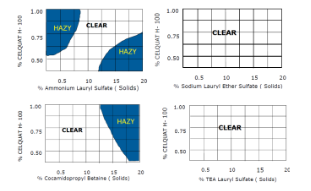
Properties
- Physical Form
- Soluble In
- Typical Properties
Value Units Test Method / Conditions Application pH Range 4 - 8 - - - SDS Physical and Chemical Properties
Value Units Test Method / Conditions Minimum Ignition Energy 100 - 300 mJ - Dust Deflagration Index 43 m.b/s - Dust Explosion Class St1 - - Bulk Density 500 kg/m³ - Lower Explosion Limit 30000 mg/m³ - Flammability (Solid, Gas) Not classified as a flammability hazard - - Ignition Temperature min. 100 °C - pH Value (at 2 % solution) 6 - 8 - - Soluble in Water - - - Compatibility
Surfactant
Even though Celquat® H-100 conditioning polymer is cationic, it is compatible with a number of commonly used anionic and amphoteric surfactants. Being lower in cationic activity, the Celquat® H-100 polymer is generally more compatible with anionics than the Celquat L-200 polymer. Compatibility largely depends on surfactant selection and concentration, as well the concentration of Celquat® H-100 polymer.
Clear shampoos can be prepared with the Celquat® H-100 polymer and such surfactants as cocamidopropyl betaine, TEA lauryl sulfate, ammonium lauryl sulfate and sodium lauryl ether sulfate within certain concentration restraints. Refer to the diagrams below for specific compatibility information.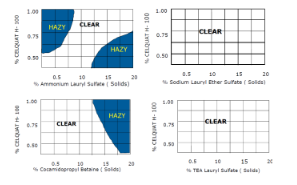
- Performance Properties
Styling applications
Celquat® H-100 conditioning polymer can be easily formulated into non-aerosol styling products. It is compatible with propellants used in mousses and carbomers used to prepare creams, lotions, and gels. Therefore, it is well suited for hair styling applications that require conditioning properties with hold, e.g. gels, mousses, and styling lotions.
Humidity resistance
Celquat® H-100 polymer has good holding power in high humidity curl retention tests. In one test procedure, hair swatches were treated with various fixatives and were combed out, formed into curls, dried, and conditioned at 50% relative humidity. They were then mounted, unwound into a helix configuration, measured and placed in a chamber maintained at 21°C and 90% relative humidity. Curl height was determined as a function of time.
Percent curl retention is calculated by the following equation:
% curl retention = L - Lt/ L - L0Where:
L = length of hair fully extended
L0 = length of hair before exposure
Lt = length of hair after exposure for time
Nine determinations were made with each sample. The results of the evaluation are given below:
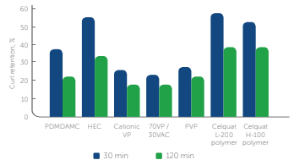
PDMDAMC: Polydimethyldiallyl Ammonium Chloride HEC: Commercial Cationic Hydroxyethyl Cellulose Cationic VP: Cationic Vinyl Pyrrolidone Copolymer 70VP / 30VAC: 70 Vinyl Pyrrolidone/ 30 Vinyl Acetate Copolymer PVP: Polyvinylpyrrolidone
Celquat® H-100 polymer was found to have superior high humidity curl retention when compared to cationic vinyl pyrrolidone copolymer, 70% vinyl pyrrolidone/30% vinyl acetate copolymer, polyvinylpyrrolidone, and poly-dimethyl diallyl ammonium chloride. The polymer did have similar high humidity curl retention when compared to the Celquat® L-200 polymer and improved curl retention compared to commercial hydroxyethyl cellulose after a two-hour time period.
Subjective evaluations
Celquat® H-100 polymer was compared to a Polyquaternium-10 polymer for leave on performance in subjective testing. The properties evaluated in this test include gloss, stiffness, dry comb, flake, antistat, dry feel, wet comb and wet feel. This evaluation was done with 1% polymer solutions on European virgin brown hair. The results indicate that Celquat® H-100 polymer had superior dry feel properties when compared to Polyquaternium-10. There were no other statistical differences.
Cleansing applications The physical and sensory properties of the Celquat® H-100 polymer make it well suited for many applications in the cleansing area. This polymer can be used in conditioning shampoos, rinse-off and leave-in conditioners, body washes, and liquid soaps.
Substantivity
The cationic charge on Celquat® H-100 polymer makes it substantive to such keratinous substrates as hair and skin. The substantivity of the Celquat® H-100 polymer has been defined using the Lumicrease dye test. In this experiment, dyeing wool swatches with an anionic polyazo sulfonate dye after they have been treated with the cationic polymer quantifies deposition of cationic conditioning polymers. Wool is similar to human hair and skin in adsorptive and charge properties and can be used as an efficient substitute substrate for hair testing. The dye is attracted to the deposited cationic polymer. A colorimeter is used to measure the degree of adsorption on each sample via intensity of the dye.The swatches are tested for deposition after 1 wash (1) and 10 washes (10). The 1 wash data is indicative of substantivity, and a significantly higher value for the 10 wash reading over the 1 wash reading is indicative of build-up. As is shown in the graph below, Celquat® H-100 polymer is significantly more substantive than the two Polyquaternium-10 polymers, and is equally substantive as the Celquat® L-200 polymer. This data also shows that this polymer does not build-up on the wool swatches during repeated washings.
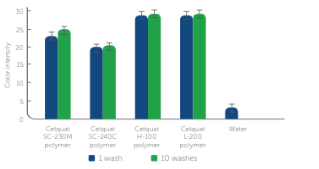
Subjective evaluations
Both subjective and objective testing confirms that the Celquat® H-100 polymer can deliver performance benefits from shampoo systems. This testing was done in rinse-off protocols
using a model shampoo base consisting of the following:Ingredient % Celquat polymer 0.5 Ammonium Laureth Sulfate 10.5 Cocamidopropyl Betaine 3.3 Cocamide MEA 0.5 Preservative 0.4 Ammonium Chloride 0.2 Water up to 100 Subjective evaluations were run (on European virgin brown hair) to compare the performance of Celquat® H-100 polymer versus a Polyquaternium-10 control. The Celquat H-100 polymer provides statistically superior gloss, dry comb, wet comb, and wet feel in comparison to the Polyquaternium-10 polymer. Performance benefits for Celquat® H-100 polymer delivered from this shampoo are also seen in objective wet comb studies.
The wet combing studies were performed using the Sintech MTS Synergie 200 tensile tester in a constant temperature humidity room. The reported values are the average data from three sets of tresses. Each tress set represents averaged data for three replicates. The data below is the average % improvement over untreated hair. The results below indicate that the Celquat® H-100 polymer gives comparable wet comb to two other conditioning polymers, and is inferior only to the Celquat® SC-230M polymer.
Wet comb improvement shampoo
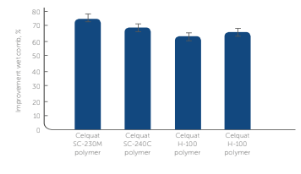
Regulatory & Compliance
- Certifications & Compliance
- Chemical Inventories
Technical Details & Test Data
- Product Information
Celquat® H-100 polymer is one member of the Celquat family of polymers that are water soluble quaternary cellulose derivatives. Other Celquat polymers offered include:
- Celquat® L-200 polymer, Polyquaternium-4
- Celquat® SC-230M polymer, Polyquaternium-10
- Celquat® SC-240C polymer, Polyquaternium-10
Polyquaternium-4 conditioning polymers are formed by grafting dimethyl diallyl ammonium chloride groups onto a cellulosic backbone. The Polyquaternium-4 polymers differ from the Polyquaternium-10 polymers in their comb-like distribution of the quaternized nitrogen charge rather than an even charge distribution. The Celquat® H-100 polymer is a high viscosity Polyquaternium-4 variant. It differs from the lower viscosity Celquat® L-200 polymer in not only molecular weight, but also its degree of cationic substitution. Celquat® H-100 polymer has approximately 1% nitrogen, which is half that of the Celquat® L-200 polymer.
Because of its higher molecular weight and lower cationic substitution, the Celquat® H-100 polymer is recommended for use in moderate to high viscosity systems that require some conditioning benefits with little build-up and/or improved compatibility with anionic ingredients.
Safety & Health
- Health and Safety
A health and safety summary for Celquat® H-100 polymer is available upon request. Information on Celquat® H-100 polymer relating to EU Cosmetic Directive 76/768/EEC is also available upon request.
This product may be used in spray applications having a droplet particle size greater than 50 microns. The product has not been properly evaluated for safety clearance for use in pumps and/or aerosols with particle sizes less than 50 microns.
The suitability of the final formulations should be confirmed in all respect by appropriate evaluation. The marketer is advised to evaluate the final formulation with regard to performance and health safety.
Packaging & Availability
Storage & Handling
- Storage Information
Celquat® H-100 polymer should be stored in a cool, dry location away from heat, sparks or fire. When not in use, the container should be kept closed to prevent moisture and dust contamination. We recommend that normal precautions be taken to avoid ingestion or contact with eyes. Respiratory protection should beused to avoid dust inhalation. Good industrial hygiene practices should be followed.
